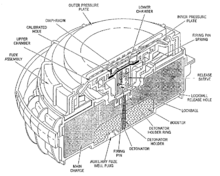VS-N fuzed mines
The VS-2.2, VS-3.6 and SH-55 are Italian circular plastic cased anti-tank blast mines that use the VS-N series fuze. They have very few metal components and are resistant to overpressure and shock. The VS-2.2 and VS-3.6 can also be deployed from helicopters. It was produced by Valsella Meccanotecnica and Singapore, but production has ceased. The VS-2.2 and VS-3.6 are essentially the same, the VS-3.6 being slightly larger, the SH-55 is larger still and has a more rounded appearance. A smaller mine, the VS-1.6 also uses the same fuze.


Description
The mines are normally olive green or sand coloured and are circular. The VS-2.2 and VS-3.6 consist of a ribbed main body containing the main charge and a large circular VS-N fuze which sits on top. The SH-55 is larger, and the circular main body is not as ribbed, it uses the same VS-N fuze as the other mines.
The VS-N fuze is air pressure driven with pressure on the top plate of the mine forcing air into a diaphragm which exerts pressure on the striker until a retaining ball is forced into a recess. Shocks from overpressure are too short to inflate the diaphragm, this requires gradual pressure giving even greater resistance to shock.
This mine has a secondary fuze well on the bottom (where it cannot be seen) which is slightly off-set from the centre of the mine. This secondary fuze well can easily be fitted with pull-fuze which functions as an anti-handling device.
The main charge of the VS-2.2 is relatively small for an anti-tank mine, so it would tend to disable rather than destroy vehicles, however the VS-3.6 and SH-55 may penetrate the hull of armoured vehicles.
The VS-2.2 mine is found in Iraq and Kuwait, the SH-55 is found in Afghanistan.
Specifications
| Mine | VS-2.2 | VS-3.6 | SH-55 |
|---|---|---|---|
| Weight | 3.5 kg | 5 kg | 7.3 kg |
| Explosive content | 2.2 kg of Composition B | 4 kg of Composition B | 5.5 kg of Composition B |
| Diameter | 230 mm | 248 mm | 280 mm |
| Height | 115 mm | 122 mm | |
| Operating pressure | 180 to 220 kg | ||